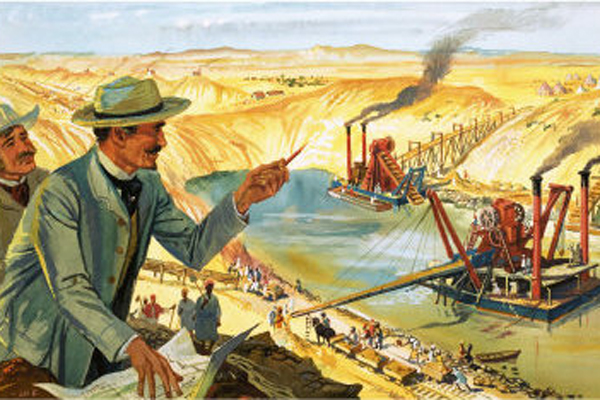30 November 1854
First concession granted by Said Pasha, son of Mohammed-Ali, to Ferdinand de Lesseps for the digging and use of a canal through the Suez isthmus for 99 years.
5 November 1857
Floatation of Suez Canal. The share price was fixed at Frf 500, and 207,229 of the 400,000 shares available were bought.
15 December 1858
Establishment of the «Compagnie universelle du canal maritime de Suez».
25 April 1859
Start of the digging of the canal at Port Said.
9 June 1859
An official order by the Egyptian government to halt work, ignored by Ferdinand de Lesseps.
23 October 1859
After meeting with Ferdinand de Lesseps, Napoleon III officially supports the canal project.
18 November 1862
The waters of the Mediterranean flow into Lake Timsah.
18 January 1863
Upon the death of Said, Ismail Pasha becomes the Viceroy of Egypt.
Turkey orders the project to be suspended.
1864
The conflict between Egypt and Turkey is resolved thanks to Napoleon III’s arbitration. The Company then abandons the fresh water canal and 60,000 hectares of irrigable land and accepts the obligation that fellahs should no longer be employed on the construction. The latter are partially replaced by machines.
19 March 1866
Ratification of the concession by the Turkish sultan, Abdul-Aziz-Khan (Egypt is a province of Turkey).
15 August 1869
The waters of the Red Sea join those of the Mediterranean.
16 November 1869
Inauguration of the Suez Canal
After the Canal
1872
The Company narrowly avoids bankruptcy.
25 November 1875
The British government buys the 176,602 Compagnie universelle du canal de Suez shares held by Ismail and thus becomes the principal shareholder.
21 February 1876
Convention solving the conflict over the tariffs for using the shipping canal.
June 1884 to February 1885
Establishment of a works programme for the widening of the Suez Canal.
1 March 1887
Authorisation for the night-time navigation of the canal.
22 December 1888
The Constantinople International Convention guaranteeing the neutrality and free use of the Suez Canal.
13 June 1956 – Suez Canal Zone is restored to Egyptian sovereignty, following British withdrawal and years of negotiations.
26 July 1956 – Egypt nationalizes the company; its Egyptian assets, rights and obligations are transferred to the Suez Canal Authority, which compensates the previous owners at the established pre-nationalization price. Egypt closes the canal to Israeli shipping as part of a broader blockade involving the Straits of Tiran and the Gulf of Aqaba
31 October 1956 to 24 April 1957 – the canal is blocked to shipping following the Suez Crisis, a conflict that leads to Israeli, and later French and British, occupation of the canal zone.
22 December 1956 – The canal zone is restored to Egyptian control, following French and British withdrawal, and the landing of UNEF troops.
5 June 1967 – the canal is blocked by Egypt, following the war with Israel; it becomes the front line during the ensuing War of Attrition and the 1973 war, remaining closed to international shipping, until general agreement was near.
10 June 1975 – The Suez Canal is re-opened for first time since 1967 war.
1 January 2008 – New rules of navigation passed by the Suez Canal Authority come into force.


